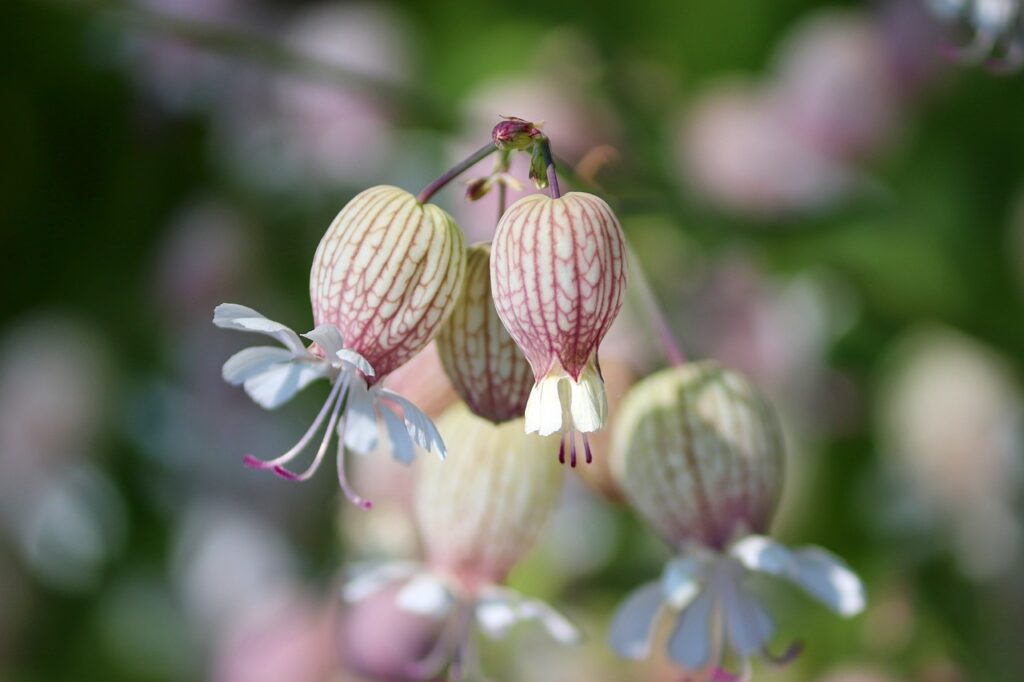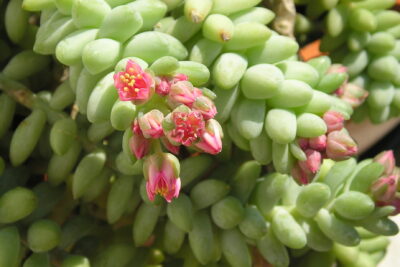
Discover Beautiful Succulents with Bell-Shaped Flowers: A Guide

Succulents are a popular type of plant known for their unique and striking appearance. With their thick and fleshy leaves, succulents have adapted to survive in arid conditions by storing water. They come in a variety of shapes, colors, and sizes, making them a favorite among gardening enthusiasts and collectors. One particular type of succulent that stands out is the bell-shaped flower variety, which adds an element of elegance and charm to any garden or indoor space.
We will explore the world of succulents with bell-shaped flowers, uncovering their beauty, characteristics, and care requirements. We will take a closer look at some of the most popular succulent species that produce bell-shaped flowers, such as the Echeveria, Crassula, and Haworthia. Additionally, we will discuss the different varieties and colors available within each species, providing inspiration for those looking to add these stunning plants to their collection. Finally, we will offer tips and advice on how to care for succulents with bell-shaped flowers, including watering, sunlight, and soil requirements, to ensure their health and longevity.
- Visit your local nursery or garden center to find a variety of succulents with bell-shaped flowers
- Research online to learn about different types of succulents that produce bell-shaped flowers
- Attend a succulent or gardening workshop to gain knowledge and tips on caring for succulents with bell-shaped flowers
- Create a dedicated space in your garden or home for growing succulents with bell-shaped flowers
- Use well-draining soil and pots with good drainage to ensure the health of your succulents
- Water your succulents with bell-shaped flowers sparingly, as they prefer dry conditions
- Provide your succulents with ample sunlight, as most succulents thrive in bright light
- Fertilize your succulents with a balanced, water-soluble fertilizer to promote healthy growth and blooming
- Regularly prune your succulents to maintain their shape and encourage more bell-shaped flowers
- Share your love for succulents with bell-shaped flowers by giving them as gifts or trading with other enthusiasts
- Frequently Asked Questions
Visit your local nursery or garden center to find a variety of succulents with bell-shaped flowers
Why Choose Succulents with Bell-Shaped Flowers?
If you're looking to add some unique and visually stunning plants to your garden or indoor space, succulents with bell-shaped flowers are an excellent choice. These plants not only offer a wide range of beautiful flower colors and shapes but also have the added benefit of being low-maintenance and drought-tolerant.
Types of Succulents with Bell-Shaped Flowers
There are numerous succulent varieties that produce bell-shaped flowers, each with its own distinct characteristics. Some popular options include:
- Echeveria: Known for their rosette-shaped foliage, Echeverias produce bell-shaped flowers in vibrant shades of pink, red, orange, and yellow.
- Crassula: Crassulas feature small, bell-shaped flowers that come in clusters. They often bloom in shades of white, pink, and red.
- Kalanchoe: Kalanchoes are known for their showy clusters of bell-shaped flowers that come in various colors, including shades of pink, yellow, and orange.
- Sinningia: Sinningias, commonly known as "Gloxinias," produce bell-shaped flowers in vibrant hues, such as purple, red, and white.
Caring for Succulents with Bell-Shaped Flowers
While succulents are generally easy to care for, it's essential to provide the right conditions to ensure the health and vitality of succulents with bell-shaped flowers. Here are some key care tips:
- Light: Succulents with bell-shaped flowers thrive in bright, indirect light. Place them near a south or east-facing window to ensure they receive adequate sunlight.
- Watering: Allow the soil to dry out completely between waterings. Overwatering can lead to root rot, so it's crucial to strike the right balance.
- Soil: Use well-draining soil specifically formulated for succulents or cacti. This helps prevent waterlogging and promotes healthy root growth.
- Temperature: Most succulents prefer moderate temperatures between 60-75°F (15-24°C). Protect them from extreme heat or cold to avoid stress.
- Fertilization: Feed your succulents with a balanced, water-soluble fertilizer during the growing season. Follow the instructions on the product for proper application.
By following these care guidelines, you can enjoy the beauty of bell-shaped flowers blooming on your succulents for an extended period.
 Thriving Succulents: Discover Fast-Growing Varieties
Thriving Succulents: Discover Fast-Growing VarietiesWhere to Find Succulents with Bell-Shaped Flowers
You can find succulents with bell-shaped flowers at your local nursery or garden center. They are often available in various sizes, allowing you to choose the perfect plants for your space. Additionally, many online retailers specialize in succulents and offer a wide selection for convenient home delivery.
So, go ahead and explore the world of succulents with bell-shaped flowers. These unique plants will not only enhance the aesthetic appeal of your garden but also provide an easy-to-care-for addition to your plant collection.
Research online to learn about different types of succulents that produce bell-shaped flowers
When it comes to succulents, there is a wide variety of species available, each with its own unique characteristics and features. If you are particularly interested in succulents that produce bell-shaped flowers, conducting online research is an excellent starting point.
By exploring various gardening websites, forums, and online communities, you can discover a plethora of information about different types of succulents that showcase these beautiful bell-shaped blooms. Websites such as SucculentCity.com and TheSpruce.com offer comprehensive guides and detailed descriptions of various succulent species, including those with bell-shaped flowers.
Explore gardening websites and forums
Gardening websites and forums are a treasure trove of knowledge when it comes to succulents. These platforms are often frequented by experienced gardeners and enthusiasts who are more than willing to share their expertise and recommendations.
Make sure to visit popular gardening websites like GardenersWorld.com, Gardenista.com, and GardeningKnowHow.com. These websites typically have dedicated sections or articles that specifically focus on succulents with bell-shaped flowers.
Additionally, participating in online gardening forums such as the Succulent Subreddit or the GardenWeb community can provide you with valuable insights and personal experiences from fellow succulent enthusiasts. Don't hesitate to ask questions and engage in discussions to expand your knowledge and discover hidden gems!
 Top Succulent Plants: Perfect Elephant Food for a Nutritious Feast
Top Succulent Plants: Perfect Elephant Food for a Nutritious FeastUtilize online plant databases
Online plant databases are another excellent resource for identifying succulent species that produce bell-shaped flowers. Websites like PlantSnap, Plantifier, and FloraFinder allow you to search for specific plant characteristics, including flower shape, size, and color.
By utilizing these databases, you can narrow down your search and find succulents with bell-shaped flowers that match your preferences. These platforms often provide detailed information about the care requirements, growth habits, and ideal growing conditions for each identified plant.
Join online gardening communities
Being part of online gardening communities can be a great way to connect with fellow succulent lovers and learn from their experiences. Platforms like Instagram and Facebook offer numerous groups and pages dedicated to succulent enthusiasts.
By joining these communities, you can not only find inspiration from stunning photos of succulents with bell-shaped flowers but also engage in conversations with experienced gardeners. Don't be afraid to ask for recommendations or share your own discoveries!
Remember, research is key when it comes to discovering beautiful succulents with bell-shaped flowers. By exploring gardening websites, forums, utilizing online plant databases, and joining online communities, you can expand your knowledge and find the perfect succulents to add to your collection.
Attend a succulent or gardening workshop to gain knowledge and tips on caring for succulents with bell-shaped flowers
Are you fascinated by the unique beauty of succulents with bell-shaped flowers? If so, attending a succulent or gardening workshop can be a fantastic way to expand your knowledge and learn valuable tips on caring for these stunning plants.
 Discover Low-Maintenance Bush-Like Plants That Resemble Succulents
Discover Low-Maintenance Bush-Like Plants That Resemble SucculentsWorkshops offer a hands-on learning experience where you can interact with experts and fellow succulent enthusiasts. Whether you are a beginner or an experienced gardener, these workshops provide a wealth of information that can help you cultivate and maintain your succulents with bell-shaped flowers in the best possible way.
During these workshops, you can expect to learn various aspects related to succulents, including their specific care requirements, propagation techniques, and how to create stunning arrangements. Experienced instructors will guide you through the process, sharing their expertise and answering any questions you may have.
Benefits of attending a succulent or gardening workshop
Attending a succulent or gardening workshop offers numerous benefits for both beginners and seasoned gardeners. Here are a few reasons why you should consider participating:
- Hands-on learning: Workshops provide a hands-on experience, allowing you to practice the techniques taught by the experts. This practical approach helps you understand the concepts better and gain confidence in caring for your succulents.
- Networking opportunities: Workshops bring together like-minded individuals who share your passion for succulents. It's a great chance to connect with fellow enthusiasts, exchange ideas, and build a network within the gardening community.
- Expert guidance: Learning directly from experienced instructors ensures that you receive accurate and reliable information about succulent care. They can provide valuable insights and tips based on their years of experience, helping you avoid common pitfalls and maximize the health and beauty of your plants.
- Access to rare varieties: Some workshops may offer access to unique and rare succulent varieties that are not easily found in regular plant nurseries. This gives you the opportunity to expand your collection and discover new favorites.
How to find succulent or gardening workshops
Finding succulent or gardening workshops in your area is relatively easy. Here are a few ways to locate upcoming workshops:
- Online search: Use popular search engines to look for workshops or events related to succulents or gardening in your city or region. This will provide you with a list of upcoming workshops and their details.
- Social media groups: Join online communities or groups dedicated to succulent gardening on platforms like Facebook or Instagram. These groups often share information about upcoming workshops, making it convenient for you to stay updated.
- Local nurseries and garden centers: Visit your local nurseries or garden centers and inquire about any upcoming workshops they may be hosting. They often organize such events to engage with the gardening community.
Attending a succulent or gardening workshop can be a delightful and educational experience. Not only will you learn valuable techniques to care for your succulents with bell-shaped flowers, but you'll also connect with fellow enthusiasts and expand your knowledge about these captivating plants.
Create a dedicated space in your garden or home for growing succulents with bell-shaped flowers
If you're a plant lover and want to add some unique beauty to your garden or home, then succulents with bell-shaped flowers are the perfect choice. These stunning plants not only add visual appeal but also require minimal care and maintenance. Creating a dedicated space for growing succulents with bell-shaped flowers will allow you to showcase their beauty and create a serene atmosphere.
Choosing the right location
Before you start planting succulents with bell-shaped flowers, it's essential to choose the right location. These plants thrive in bright, indirect sunlight, so look for a spot in your garden or home that receives ample light throughout the day. Avoid placing them in areas with intense, direct sunlight as it can scorch their delicate leaves.
 Top Yellow Flowering Succulent Ground Cover Options for Your Garden
Top Yellow Flowering Succulent Ground Cover Options for Your GardenPreparing the soil
Preparing the soil is crucial for the successful growth of succulents with bell-shaped flowers. They prefer well-draining soil that allows excess water to flow away, preventing root rot. You can create a suitable soil mix by combining regular potting soil with sand or perlite to improve drainage. This will ensure that your succulents receive the right amount of moisture without becoming waterlogged.
Choosing the right succulents
When selecting succulents with bell-shaped flowers, consider their growth habits, color variations, and overall size. Some popular choices include Echeveria, Kalanchoe, and Crassula. These plants come in a range of colors, from vibrant pinks and purples to soft pastels, allowing you to create a visually appealing display.
Planting and caring for succulents
Once you have chosen the right succulents, it's time to plant them in your dedicated space. Dig a small hole in the soil and gently place the succulent in it, ensuring that the roots are covered. Water the plant lightly, allowing the soil to dry out completely between waterings. Overwatering can lead to root rot, so it's crucial to find the right balance.
Additionally, succulents with bell-shaped flowers don't require frequent fertilization. A diluted succulent fertilizer once or twice a year is sufficient to provide them with the necessary nutrients. As these plants store water in their leaves, they are drought-tolerant and can withstand periods of neglect.
Adding decorative elements
To enhance the beauty of your dedicated succulent space, consider adding decorative elements such as rocks, pebbles, or driftwood. These natural elements not only provide visual interest but also help with moisture retention and drainage. Arrange them strategically around your succulents to create an attractive and cohesive display.
By creating a dedicated space for growing succulents with bell-shaped flowers, you'll be able to enjoy their beauty year-round. With their low-maintenance requirements and stunning blooms, these plants are sure to become the centerpiece of your garden or home.
Use well-draining soil and pots with good drainage to ensure the health of your succulents
 Dramatic Succulents: Discover the Varieties with Striking, Long Leaves
Dramatic Succulents: Discover the Varieties with Striking, Long LeavesWhen it comes to caring for succulents, one of the most important factors to consider is the type of soil and pots you use. Succulents thrive in well-draining soil that allows excess water to flow out easily. This is because succulents are adapted to survive in arid conditions and are susceptible to root rot if their roots sit in water for too long.
When choosing soil for your succulents, look for a mix that is specifically formulated for these plants. These mixes usually contain a combination of organic matter, such as peat moss or coconut coir, and inorganic materials like perlite or pumice. The organic matter helps retain some moisture and provides nutrients, while the inorganic materials promote drainage.
Additionally, it's crucial to select pots with good drainage holes. This allows excess water to escape, preventing waterlogged roots and potential rot. Terra cotta pots are a popular choice for succulents as they are porous and allow for better airflow, but any pot with drainage holes will do. Avoid using pots without drainage holes or pots with saucers that retain water, as these can lead to overwatering and harm your succulents.
Remember to repot your succulents every couple of years to refresh the soil and ensure proper drainage. This will prevent the soil from becoming compacted over time and hindering drainage.
The Importance of Proper Watering for Succulents
Watering succulents can be a bit tricky, as they have different needs compared to other houseplants. Succulents store water in their leaves, stems, or roots, allowing them to survive in drought-like conditions. Overwatering is one of the most common mistakes made when caring for succulents, so it's essential to understand their watering requirements.
As a general rule of thumb, it's best to underwater rather than overwater succulents. Allow the soil to dry out completely between waterings, and then thoroughly saturate the soil when watering. This mimics the natural rainfall patterns in their native habitats and prevents water from sitting in the pot for too long.
However, it's important to note that the watering frequency can vary depending on factors such as the size of the pot, the type of succulent, and the surrounding environment. It's always a good idea to observe your succulents closely and adjust your watering schedule accordingly.
 Best Heat-Resistant Succulents: Thriving in High Temperatures
Best Heat-Resistant Succulents: Thriving in High TemperaturesRemember, succulents are hardy plants that can tolerate dry conditions, but they still need water to thrive. Finding the right balance is key to keeping your succulents healthy and beautiful.
Water your succulents with bell-shaped flowers sparingly, as they prefer dry conditions
Succulents with bell-shaped flowers are a stunning addition to any garden or indoor space. These unique plants thrive in dry conditions and require minimal maintenance. If you're looking to add some beauty and elegance to your garden, here's a guide to help you discover and care for succulents with bell-shaped flowers.
Choosing the right succulents
When selecting succulents with bell-shaped flowers, it's essential to consider the growing conditions, such as the amount of sunlight and temperature they require. Some popular varieties with bell-shaped flowers include Echeveria, Kalanchoe, and Aloe. These plants are known for their vibrant blooms and ability to withstand drought-like conditions.
Pro Tip: Look for succulents with thick, fleshy leaves, as these are signs of their ability to store water efficiently.
Planting and caring for succulents with bell-shaped flowers
Before planting your succulents, ensure that you have well-draining soil. Succulents are prone to root rot if exposed to excessive moisture. Mix regular potting soil with sand or perlite to create the perfect well-draining medium.
When planting, ensure that the succulent's roots are covered but not buried too deeply. Leave some space between the soil and the rim of the pot to prevent water from pooling around the plant.
 Explore Stunning Tri Color Succulents: Discover Vibrant Varieties!
Explore Stunning Tri Color Succulents: Discover Vibrant Varieties!Pro Tip: Succulents with bell-shaped flowers thrive in bright light, so place them near a sunny window or in a spot with indirect sunlight.
Watering and fertilizing
Succulents with bell-shaped flowers have adapted to survive in arid conditions, so they require minimal watering. Water them sparingly, allowing the soil to dry out completely between waterings. Overwatering can lead to root rot and other issues, so it's crucial to strike the right balance.
When it comes to fertilizing, use a balanced liquid fertilizer diluted to half strength. Apply the fertilizer during the growing season, typically spring and summer, following the instructions on the package.
Protecting your succulents
Succulents with bell-shaped flowers are generally hardy plants, but they can still face some challenges. Protect them from extreme temperatures, especially frost, as it can damage or kill the plant. If you live in an area with harsh winters, consider bringing your succulents indoors for the colder months.
Additionally, keep an eye out for pests such as mealybugs and aphids. Regularly inspect your plants and treat any infestations promptly to prevent damage.
Succulents with bell-shaped flowers are a visually appealing and low-maintenance option for any plant lover. By following these guidelines, you can create a beautiful succulent garden or enhance your indoor space with these elegant plants. Remember to provide them with the right conditions, including well-draining soil, proper watering, and protection from extreme temperatures. With a little care, your succulents with bell-shaped flowers will thrive and bring joy for years to come.
Provide your succulents with ample sunlight, as most succulents thrive in bright light
 Indoor Succulents: Soft-Leaved Varieties Available?
Indoor Succulents: Soft-Leaved Varieties Available?Succulents are known for their ability to thrive in arid environments, and one key factor in their growth and development is sunlight. These plants have adapted to withstand long periods of intense sunlight, making them perfect for bright, sunny locations in your home or garden.
When it comes to providing sunlight for your succulents, it's important to strike the right balance. While they need plenty of light to grow and stay healthy, too much direct sunlight can cause their leaves to burn or develop a bleached appearance. On the other hand, insufficient light can lead to elongated stems and pale, weak growth.
To ensure your succulents receive the right amount of sunlight, it's best to place them in a location that receives bright, indirect light for most of the day. A south-facing window or a spot on your patio that gets ample sunlight is ideal. If you're growing succulents indoors, you can consider using artificial grow lights to supplement natural light.
It's worth noting that different types of succulents have varying light requirements. While most succulents prefer bright light, some species, such as Haworthias and Gasterias, can tolerate lower light conditions. Before bringing home new succulents, it's a good idea to research their specific light needs to ensure optimal growth and flowering.
Remember to monitor your succulents closely for any signs of sunburn or etiolation. If you notice any discoloration or stretching of the stems, it's a sign that they may be receiving too much or too little light. Adjust their placement accordingly to provide the ideal lighting conditions for their well-being.
Providing your succulents with ample sunlight is crucial for their overall health and beauty. By understanding their light requirements and finding the right balance, you can enjoy vibrant, thriving succulents with bell-shaped flowers that will enhance the aesthetic appeal of your home or garden.
Fertilize your succulents with a balanced, water-soluble fertilizer to promote healthy growth and blooming
 Exploring the Unique World of Blue Succulent Plants: Are They Real?
Exploring the Unique World of Blue Succulent Plants: Are They Real?Succulents are known for their stunning and unique bell-shaped flowers, which add a touch of elegance to any garden or indoor space. If you want to enjoy the beauty of these flowering succulents, it's essential to provide them with the right care and nourishment. Fertilizing your succulents with a balanced, water-soluble fertilizer is one of the key steps to promote healthy growth and blooming.
When choosing a fertilizer for your succulents, opt for a well-balanced formula that contains equal amounts of nitrogen, phosphorus, and potassium (NPK). This balanced combination ensures that your succulents receive all the necessary nutrients for their overall growth and flower production.
To apply the fertilizer, dilute it according to the instructions on the packaging. It's crucial not to over-fertilize your succulents, as excessive nutrients can lead to burnt roots and other issues. A general rule of thumb is to fertilize your succulents once every four to six weeks during the growing season, which typically occurs in spring and summer.
Before applying the fertilizer, make sure the soil is moist. Watering your succulents a day or two before fertilizing helps prevent any potential damage to the roots. Apply the diluted fertilizer to the soil around the base of the succulent, avoiding direct contact with the leaves or stems.
Remember to adjust the amount of fertilizer based on the size and age of your succulents. Younger succulents may require less fertilizer compared to mature ones. Observing the growth and health of your succulents can also guide you in determining the appropriate amount of fertilizer to use.
In addition to a balanced fertilizer, it's important to provide your succulents with adequate sunlight, well-draining soil, and proper watering. These factors, when combined with regular fertilization, contribute to the overall health and blooming of your succulents.
By following these guidelines and providing your succulents with the necessary care, you can enjoy the beauty of their bell-shaped flowers in all their glory. Whether you're a seasoned succulent enthusiast or just beginning to explore these mesmerizing plants, the joy of witnessing your succulents bloom is truly a sight to behold.
 Uncover Profitable Succulent Varieties for Lucrative Returns
Uncover Profitable Succulent Varieties for Lucrative ReturnsRegularly prune your succulents to maintain their shape and encourage more bell-shaped flowers
Succulents are known for their unique and diverse shapes, but if you're specifically interested in those with bell-shaped flowers, regular pruning is crucial. Pruning not only helps maintain the desired shape of your succulents but also stimulates the growth of more bell-shaped blooms.
When it comes to pruning succulents, it's important to keep a few things in mind. Firstly, choose the right tools for the job. A sharp pair of pruning shears or scissors will allow you to make clean cuts without damaging the plant. Additionally, always make sure your tools are clean and disinfected to prevent the spread of diseases.
Before you start pruning, take a moment to assess your succulent's overall shape. Look for any branches or stems that have become leggy, overgrown, or damaged. These are the areas that you'll want to focus on during the pruning process.
Start by identifying the point where you want to make your cut. It's best to trim just above a leaf node or a joint. This will encourage new growth in that area, resulting in a more compact and bushy plant. Make your cut at a slight angle to prevent water from pooling on top of the cut surface.
As you prune, remember that succulents are resilient plants, so don't be afraid to remove a significant amount of growth if needed. This will help redirect the plant's energy towards producing more bell-shaped flowers. However, be cautious not to remove too much at once, as it can shock the plant and hinder its recovery.
After pruning, take a moment to assess the overall balance and symmetry of your succulent. If necessary, you can further shape the plant by selectively removing additional branches or stems. This process will help create a visually appealing and well-proportioned succulent that showcases its bell-shaped flowers.
Lastly, don't forget to dispose of any pruned material properly. Succulent cuttings can often be propagated to create new plants, so consider propagating any healthy trimmings instead of discarding them. This way, you can expand your succulent collection while also promoting sustainability.
By regularly pruning your succulents, you can maintain their shape and encourage the growth of beautiful bell-shaped flowers. Remember to use the appropriate tools, make clean cuts, and assess the overall balance of your plants. With proper care and attention, your succulents will thrive and become stunning additions to your garden or indoor space.
Are you a succulent enthusiast looking to share your love for these unique plants with others? Consider gifting or trading succulents with bell-shaped flowers! These stunning plants not only make beautiful additions to any garden or indoor space, but they also add a touch of elegance with their delicate bell-shaped blooms.
Whether you're an experienced collector or just starting your succulent journey, here's a guide to help you discover some of the most captivating succulents with bell-shaped flowers:
1. Echeveria 'Afterglow'
Echeveria 'Afterglow' is a popular succulent known for its pastel-colored leaves and charming bell-shaped flowers. With a rosette-like growth pattern, this variety produces clusters of pinkish-lavender flowers that add a soft and dreamy touch to any arrangement or garden bed.
2. Kalanchoe 'Mother of Thousands'
Kalanchoe 'Mother of Thousands' is an eye-catching succulent with unique bell-shaped flowers. It gets its name from the plantlets that grow along the edges of its leaves, resembling tiny "baby plants." This variety produces clusters of vibrant red, orange, or yellow flowers, creating a striking contrast against its green foliage.
3. Dudleya pulverulenta
Dudleya pulverulenta, also known as "Chalk Liveforever," is a succulent native to California. Its pale blue-green leaves form a rosette shape, while its bell-shaped flowers bloom in shades of pink or white. This drought-tolerant succulent is a perfect choice for xeriscape gardens or rock gardens.
4. Crassula ovata
Crassula ovata, commonly known as "Jade Plant" or "Money Tree," is a versatile succulent with bell-shaped flowers. It features glossy, oval-shaped leaves and produces clusters of small, white or pink flowers. This succulent is believed to bring good luck and prosperity, making it an excellent gift for loved ones.
5. Aloe 'Bellatula'
Aloe 'Bellatula' is a unique succulent with slender, tubular leaves and bell-shaped flowers that bloom in shades of orange or red. This variety adds a touch of drama to any succulent collection with its architectural form and vibrant floral display.
- Echeveria 'Afterglow'
- Kalanchoe 'Mother of Thousands'
- Dudleya pulverulenta
- Crassula ovata
- Aloe 'Bellatula'
These succulents not only make stunning additions to your own collection but also make thoughtful gifts for fellow succulent lovers. Consider trading cuttings or potted plants with other enthusiasts to expand your collection and foster a sense of community among succulent enthusiasts.
Remember to provide proper care and maintenance instructions when gifting or trading succulents to ensure their longevity and well-being. With their unique bell-shaped flowers, these succulents are bound to captivate anyone who receives them!
Frequently Asked Questions
1. What are succulents?
Succulents are plants that store water in their leaves, stems, or roots, enabling them to survive in arid environments. They have fleshy, thickened leaves and are known for their unique and diverse shapes and colors.
2. What are bell-shaped flowers?
Bell-shaped flowers refer to floral blooms that have a narrow tube or corolla at the base, which then opens up into a wider, bell-like shape. These flowers are often found in various plant species, including succulents.
3. Which succulents have bell-shaped flowers?
Several succulents produce bell-shaped flowers, including the popular Echeveria, Sedum, and Kalanchoe varieties. Other examples include Aloe bellatula, Graptopetalum bellum, and Dudleya abramsii.
4. How do I care for succulents with bell-shaped flowers?
To care for succulents with bell-shaped flowers, it is important to provide them with well-draining soil, adequate sunlight, and infrequent but thorough watering. Avoid overwatering as it can lead to root rot. Additionally, protect them from extreme temperatures and provide occasional fertilization during their active growth periods.
If you want to read more articles similar to Discover Beautiful Succulents with Bell-Shaped Flowers: A Guide, you can visit the Varieties and Colors category.






You Must Read